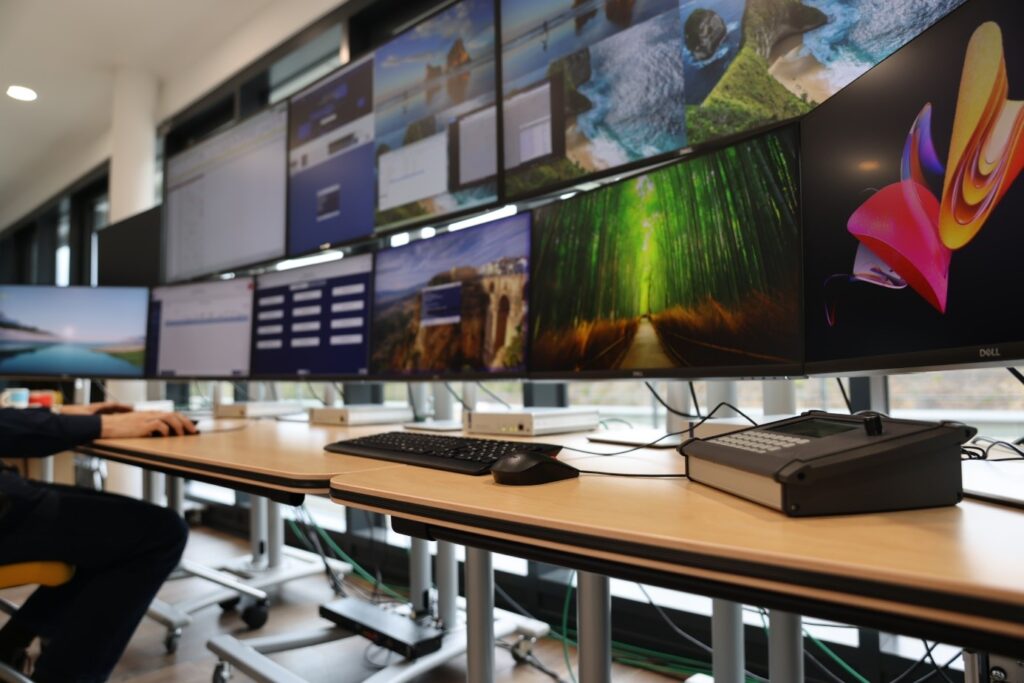A Proof of Concept (PoC) is designed to demonstrate that a proposed solution works in practice and meets all technical requirements. Christian Hevicke, Senior Solutions Architect at G&D, recently conducted a PoC with a leading automation technology provider. In this interview, he shares fascinating insights into the PoC, which successfully proved the technical feasibility of even the most complex requirements using our solutions and expertise.

What was the objective of this Proof of Concept?
The core goal was to validate a control room solution for an automation solutions provider – based on a specialized workplace concept developed by the customer. With various use scenarios defined, we implemented them technically in collaboration with our integration partner. The task was to set up a realistic, functioning overall system – exactly as it would be used later in practice.
It was important to us not just to provide hardware – we wanted to contribute our full expertise. Together with our partner, we offered an all-in-one package: from the workplace setup and KVM infrastructure to the network – everything from a single source. We handled the entire setup and configuration and carried out the PoC on-site over two days.
Were there any particular challenges?
From a technical standpoint, the concept was straightforward to implement for us. However, it was essential to convey all the necessary foundational knowledge to the customer in a short amount of time and demonstrate both the functionality and real-world application of the solution.
Our preparation made the critical difference. We had a clear understanding of what the customer wanted to see and were able to tailor the PoC accordingly. In addition, we demonstrated added value that our solutions offer. With our experience, we have presented further possibilities that will bring the customer long-term benefits. The feedback at the end was very positive.

Can you explain the workplace concept in more detail?
Like in many industries today, operator stations are increasingly being consolidated and optimized for efficiency and effectiveness. The technology used enables a targeted, resource-optimized setup and ensures that users always have an overview of all tasks. Various work and monitoring areas can be flexibly displayed on monitors and video walls. Users typically operate from a central area where they primarily focus on their applications. At the same time, they must monitor surrounding systems. If an event occurs, these systems can be brought into focus and addressed directly.
The automation technology effectively supports users in this: the automation solutions providers’ system landscape provides many relevant technical parameters automatically. These can be ideally integrated with the KVM systems. This reduces potential error sources and allows for quick, simple, and practical implementation. The result is a streamlined, customized, and powerful technical environment for the end customer.
A particular focus for the customer was the division of workplace zones: six monitors on the desk plus three video walls above were to function as a seamlessly integrated unit – as a unified system. The goal was to implement the customer-defined scenarios precisely, while keeping the solution flexible for future user-led modifications. In other words: a fully flexible system that allows users to independently expand or personalize – supporting a future-proof, user-friendly system architecture.
Technologies used in the PoC:
- Redundant IP matrix: 2× ControlCenter-IP in DirectRedundancy mode for uninterrupted operation
- PersonalWorkplace-Controller for flexible arrangement and operation of computer sources
- Control-API for external control of the KVM system
- Multi-monitor operator station: 6 monitors + 3 video walls
- Flexible switching and control devices
When do we offer a Proof of Concept?
We typically offer a PoC when a concrete concept has already been developed, and it’s time to verify its technical and practical feasibility – exactly as envisioned by the customer. It’s usually not an entry-level step, but a more advanced one, requiring all parties to have a foundational understanding of the devices and the KVM system landscape.
A solid economic perspective is also essential. A PoC involves a certain level of effort – technically and in terms of personnel – and this effort must be justified by the potential for a successful joint project.
Why is it important to offer customized solutions?
In my view, it’s crucial to show that we not only want to understand our customers, but that we actually can. We’re able to comprehend their operational context – their projects, their systems, and their specific processes. That’s how we identify what the customer truly needs and why they see a KVM solution as an essential part of their infrastructure.
As a control room solutions provider, we are equipped to meet growing and increasingly complex demands – both through our high-performance products and the people who know how to use them effectively.
Conclusion: high-end technology that delivers on its promise
The Proof of Concept was a complete success: the automation solutions provider now has a powerful system to incorporate into their portfolio and present live to potential end customers. Since the customer’s showroom is still under construction, we kept our installation operational – and successfully demonstrated performance and reliability in multiple global live demos.
This project clearly illustrates the importance of close customer coordination, technical understanding, and flexible system solutions. By implementing all requirements and seamlessly integrating the KVM technology, a practical and sustainable solution was created – with lasting benefits for all stakeholders.
>> Other articles you might be interested in:
KVM-over-IP – less secure than a classical system? Debunking the myth
SecureCert: New Feature for Mission-Critical Infrastructures
- 40 Years – 4 Perspectives: G&D through Four Different Lenses - 16. December 2025
- Trusted. Improved. VisionXS 2.0 - 15. October 2025
- bluedec™ – Our Video Compression for Control Rooms, Now Even More Powerful - 2. September 2025

